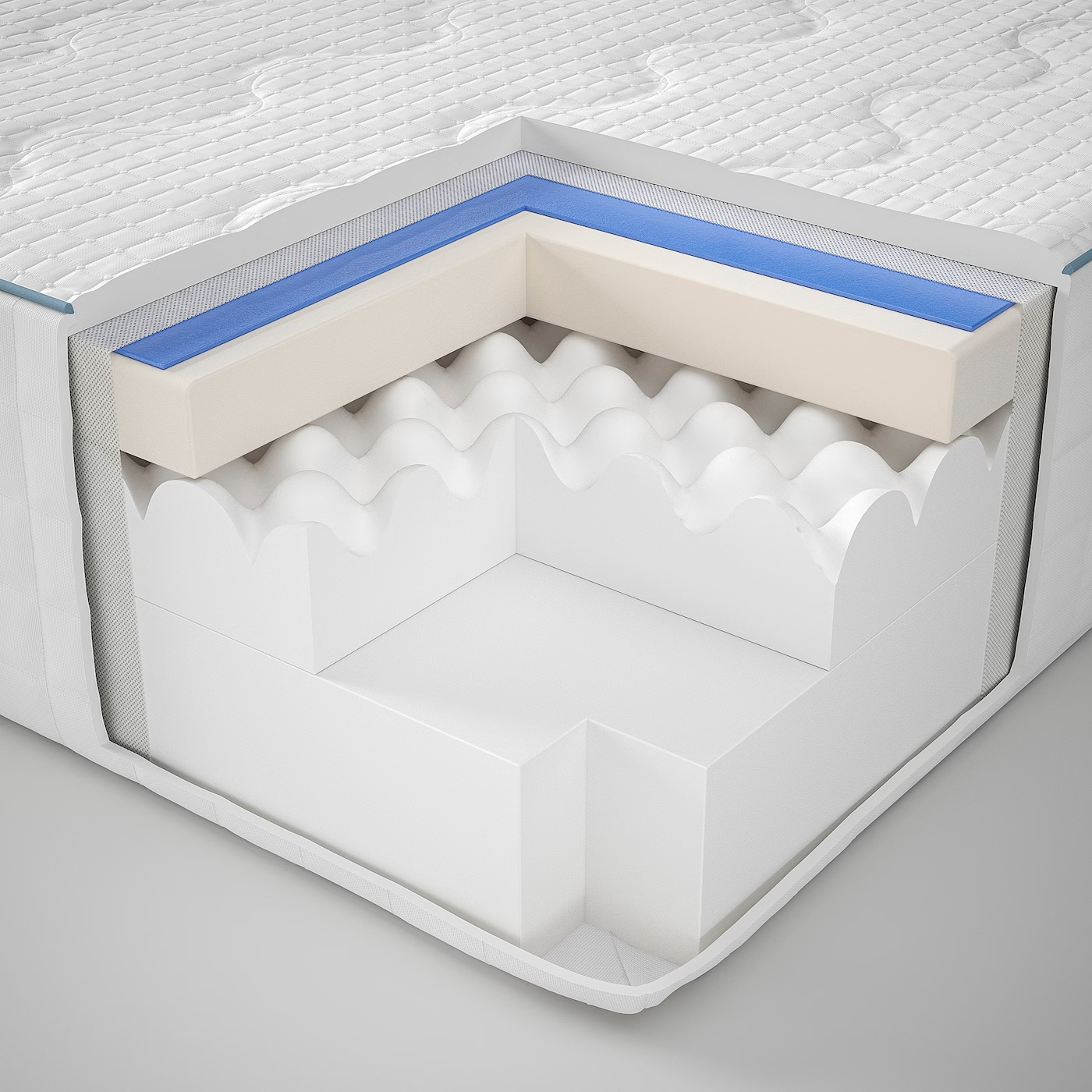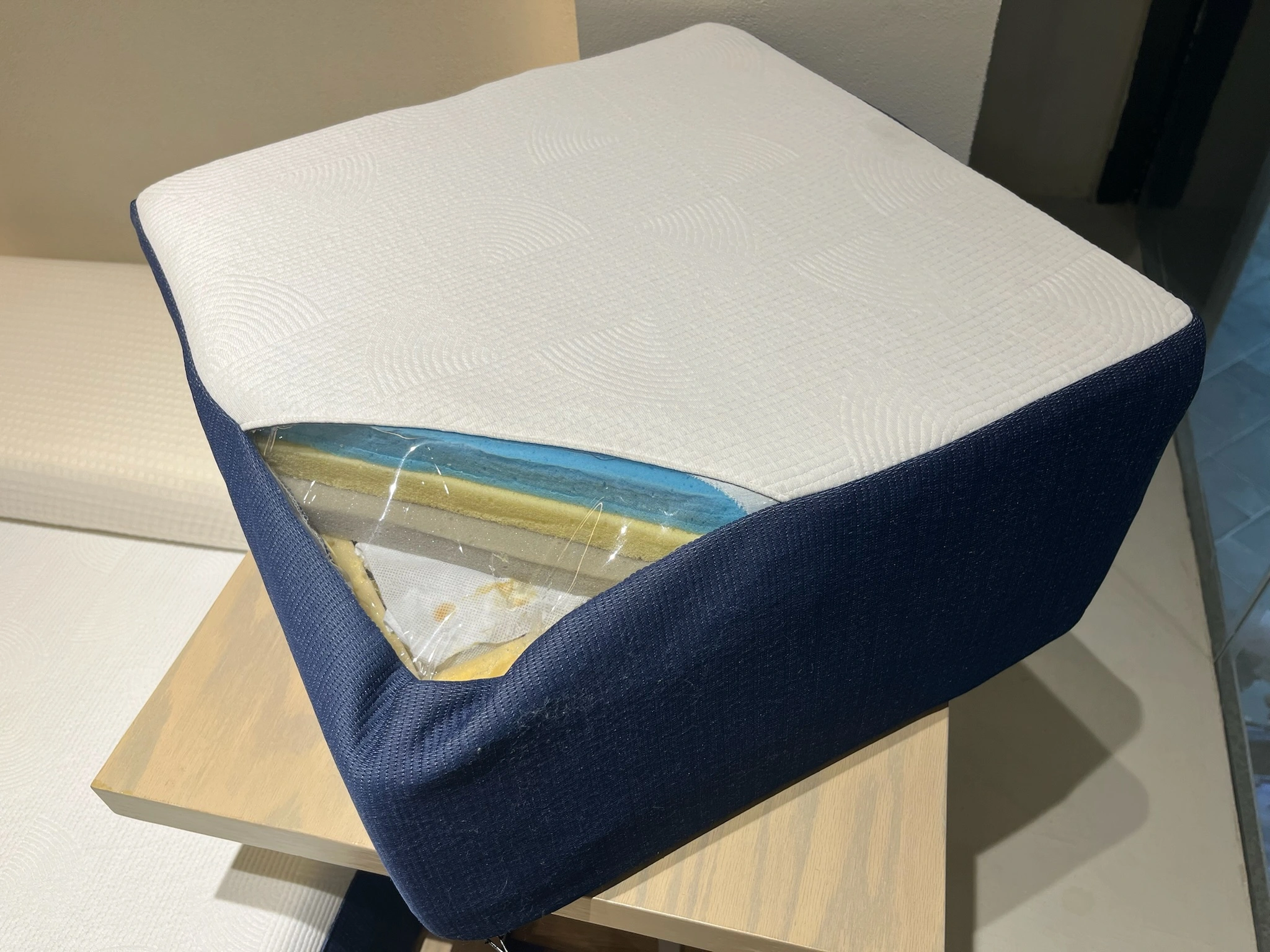All-foam mattresses have been witnessing a spike in popularity at the moment, with many people searching for the best mattress that matches their sleeping preference, two of the most popular types of mattresses in that category is the memory foam mattresses and latex mattresses, with each one has it’s own distinct feel and unique features, in this guide we will help you to find out more about memory foam and latex mattress, and decide which mattress better suits your sleeping needs.
What is Memory Foam?
Memory foam mattresses are popular among people who are looking for a soft and pressure-relieving mattress, as they're known for their ability to contour and adapt to body shape and movement. It also creates a body-hugging feel that many people find relaxing and comforting.
Memory foam is made up of a material called visco-elastic polyurethane foam. Polyurethane is a very commonly used plastic polymer. It can be used to produce a variety of materials, such as furniture like sofas and mattresses, insulation products such as liquid paints, car parts, spray foam, primers, and many other things.
For more information about memory foam mattresses check our article “What is a Memory Foam Mattress?”
Types of Memory Foam
Classic Memory Foam
The traditional type of memory foam mattress is designed to adapt and contour to the shape of the body and its unique movement by absorbing the body heat and adapting according to it, however, the classic memory foam mattresses are known to retain a significant amount of body heat, as it doesn’t have any additional features or infusions, the retention of that heat sometimes makes the mattress extra soft and uncomfortable to sleep on.
Open-Cell Memory Foam
Open-cell memory foam mattresses are almost identical to traditional memory foam but with one major addition, which is the internal pockets, hence the name “Open-cell”, these internal pockets promote airflow and add to the breathability and overall ventilation of the mattress.
Gel Memory Foam
Another way of resisting the heat retention issue was by infusing the memory foam with Gel, copper, graphite, and other infusions, which also created an internal pocket, but it’s different than the open-cell ones as these pockets are a lot more active in absorbing and dispersing the heat from the mattress.
Construction of Memory Foam Mattress

The main construction of memory foam mattresses consists of a top comfort layer, then a transitional layer of one or multiple layers of dense foam, and then at the bottom, there’s the base layer which is made from thick foam to maintain the overall structure of the mattress.
The comfort layer is designed specifically to adapt to the body shape and movements, meaning the transitional layer is more firm and dense and it’s also designed to regulate the temperature of the mattress, and finally the final layer of the mattress, also known as the core, is responsible for the stability and support of the mattress.
What is Latex Foam?
A latex mattress is a type of mattress that is made by combining natural or synthetic latex with springs or another form of foam.
Latex is a natural material acquired from the sap of rubber trees, when the sap is extracted and processed to get the structure and consistency of dense foam.
Latex has a rubber-like consistency, which makes it very bouncy and responsive, but firmer and less conforming than other foam materials such as polyfoam or memory foam.
For more information about Latex mattresses check our article “What is Latex Mattress?”
Types of latex
Dunlop
Dunlop is a common way of latex and it’s made by pouring the natural rubber tree sap into the mold, but all the sap has to be poured at the same time, which makes the Dunlop latex 100% natural, as it was made without any fillers, however, it can settle unevenly and it can also produce foam that is softer on the top and firmer at the bottom.
Talalay
Talalay latex is created from natural latex, but unlike Dunlop, it is poured in phases, and after each pour, the mold is vacuumed to verify that the latex is consistent and homogeneous, before the latex layer is frozen and reheated.
The Talalay latex, on the other hand, will never be 100% natural like the Dunlop since the manufacturing method needs the use of artificial fillers.
Synthetic
Synthetic latex is made with petrochemicals that are processed to mimic the feel of natural latex layers. Synthetic latex may not bother those with latex allergies, but it is not as durable as natural latex.
Synthetic latex is made from petrochemicals that are processed to resemble the texture of natural latex layers. While synthetic latex is not as durable as natural latex, it may not affect people with latex allergies.
Blended latex
Blended Latex is made by mixing synthetic latex with natural latex, this makes it more budget-friendly and lowers the amount of chemicals in it.
Construction of Latex Mattresses

Latex foam can be constructed from three different types of materials: all-natural latex, synthetic latex, or blended latex. There are many ways to process and manufacture latex. However, the two most common types are the Dunlop and Talalay.
Differences Between Memory Foam Mattresses And Latex Mattresses
Pressure Relief
Pressure relief is a crucial element when it comes to choosing your mattress, and while latex mattresses are bouncier and will alleviate the tension from pressure points, memory foam is a much better choice in terms of pressure relief, as it adapts and contours to the body shape and movement according to the body heat composition.
Lifespan & Durability
Memory foam mattresses’ average lifespan is between 8 to 12 years, but it completely depends on the overall maintenance of the mattress and whether it’s taken care of or not.
Latex mattresses can last longer than memory foam with proper maintenance as it’s one of the most sturdy mattresses on the market, especially all-natural Latex which can last up to 15-20 years.
Feel
Memory foam is characterized by its cradling and body-hugging feeling, as the mattress lets you sink into it, and many people like that feeling, however, some people might feel stuck and unable to move.
On the other hand, a Latex mattress has a much firmer surface to prevent excessive sinking and promote ease of movement, meanwhile, it’s still very responsive and adaptive, which makes it a better option for sleepers who toss and turn a lot of their sleep
Sleeping Positions
- Back sleepers should enjoy latex and memory foam, though memory foam will provide more pressure relief to the shoulders in this position. If you sleep on your side, you need a bed that relieves pressure in your hips and shoulders. Memory foam mattresses mitigate pressure well, while latex mattresses are more supportive and may not provide the same level of pressure relief.
- Stomach sleepers need a mattress that will keep their spine in alignment. Both latex and memory foam mattresses can provide the necessary support, but memory foam may be more likely to cause sinkage in the midsection and lead to pain.
- Combination sleepers will likely prefer latex, as the bouncier materials should foster easier repositioning.
- Side sleepers: will prefer memory foam as it will deeply cushion their hips and shoulders.
Cooling
Memory foam is famous for the heat retention issue, as it absorbs the body heat to soften and mold to the body shape, and because of that it can overheat and become extra soft, but latex doesn’t have this issue at all, as it’s temperature-neutral material, it’s much more breathable and temperature regulating, that’s why latex mattresses are a better fit for hot sleepers, even though some memory foam types addressed the overheating issues and implemented new technologies to prevent it like the open-cell and the gel infused memory foam.
Hypoallergenic
Latex and memory foam, both have hypoallergenic properties, and they could prevent the buildup of common allergens, however, some people have an allergy to natural latex, in that case, it’s preferred that they use synthetic latex or memory foam.
Motion Transfer
Memory foam mattresses feature minimal motion transfer, which makes them excellent for couples and bed-sharing because that means you will feel less of your partner's movements during the night
Latex, on the other hand, does not absorb motion as well as memory foam. Because latex mattresses are bouncy and have a short response time, you are more likely to notice your companion tossing and turning in bed.
Price
The price of a mattress depends on its size, brand, materials, design, and features. Latex mattresses are typically more expensive than memory foam mattresses.
This material isn’t cheap, but it lasts longer than memory foam. Plus, you may be able to save a few hundred dollars by shopping online and using coupons.
Should You Get a Memory Foam or Latex Mattress?
Choose memory foam if:
- You prioritize pressure relief and conforming comfort: Memory foam mattresses adapt and contour to the body shape, which alleviates the pressure from areas such as the back, hips, and shoulders.
- You suffer from back pain or joint pain: Memory foam mattresses absorb the body heat and use it to soften up the mattress, which relieves the pressure from joints and promotes equal body distribution.
- You sleep on your side or back: back and side sleepers might experience tension build up on their pressure points, which could cause discomfort during sleeping, due to the pressure-relieving properties of the memory foam you won’t encounter this issue.
- You value a quieter sleep experience: Unlike hybrid or innerspring mattresses, memory foam mattresses don’t have coils in their construction, which eliminates the possibility of squeaking and screeching noises caused by movement.
- You're on a tighter budget: Latex mattresses are known for having big price tags, meanwhile, memory foam is more affordable and offers similar properties, so if you’re on a tight budget you should consider it.
Choose latex if:
- You prefer a more responsive and bouncy feel: latex mattresses are much more bouncy and responsive than memory foam, which prevents that “stuck” feeling and promotes ease of movement.
- You value breathability and temperature regulation: latex mattress is a very breathable material due to the air bubbles that are trapped in the layers as the rubber sap is made into foam, which regulates the surface temperature of the bed and makes the mattress more breathable.
- You have allergies or sensitivities to synthetic materials: Latex is a hypoallergenic material and it prevents the buildup of common allergens such as dust mites, which can be especially beneficial for people with allergies.
- You're looking for a more durable and eco-friendly option: Latex is made from the sap of rubber trees, which makes it a very natural and durable material, especially all-natural latex.
FAQ
Which lasts longer latex or memory foam?
Although memory foam could last for 8 to 12 years if it’s well maintained, latex is a much more durable and sturdy material in the market and could last way longer if it’s properly taken care of and could last up to 20 years
Which is better for side sleepers Latex or memory foam?
Side sleepers tend to like softer surfaces that alleviate the constraint from their pressure points, that’s why memory foam is a much better option for side sleepers as it not only has an excellent pressure relief performance, but it contours and adapts according to the pressure and the body heat to create a unique mold for each body
Is latex or memory foam better for back pain?
Memory foam is the better choice if you suffer from back pain, as it provides a better pressure reliving performance, than the latex mattress.
Memory foam absorbs the body heat and becomes more soft and contoured according to the body which alleviates any tension from the pressure points, it also helps maintain the natural spinal alignment and provides lumber support.
Is a latex mattress better than memory foam?
Latex and memory foam have a lot of features in common, however, each one has its unique qualities that accommodate different sleeping preferences, so if you’re looking for a responsive mattress that is extremely durable, eco-friendly, and has an excellent cooling performance, then latex mattresses might be for you.
Conclusion
Both latex and memory foam have their pros and cons, and it’s important to choose wisely which one fits your sleeping style and preferences.
Latex foam is better for those looking for a more natural, more durable mattress with a faster response time, meanwhile, memory foam, provides better pressure relief, and motion isolation, and it’s more budget-friendly.
Dom Abraham
As the lead content writer at Sleepiverse. Dom pours his heart into writing mattress reviews, bedding product reviews, and medically-reviewed health articles. Dom is from Portugal and likes to spend his free time writing on the beach as it gives him a sense of comfort. Aside from writing mattress reviews in front of the soothing beach view, Dom likes to experiment with new amazing food ideas.


